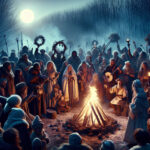The Baltic region has a long and storied history full of pagan symbols and rituals. From the ancient Baltic gods and goddesses to the sacred objects used in worship, many of these symbols still exist today. This article will explore the various meanings and significance of these Baltic Pagan symbols, and their relevance to modern-day Baltic culture. It will also discuss the importance of preserving and respecting these symbols and their connection to the unique Baltic spiritual heritage.

The Baltic pagan symbols are an important part of the heritage and culture of the Baltic states. They represent a variety of beliefs, practices and values that were once part of the spiritual life of the people living in the region. From the Baltic gods and goddesses, to the symbols of fertility, protection and luck, the pagan symbols are an important part of the traditional culture of the Baltic states.
What Are Baltic Pagan Symbols?
Baltic pagan symbols represent a range of beliefs, practices and values that were once part of the spiritual life of the people living in the region. The symbols embody a variety of deities and other spiritual beings, as well as symbols of fertility, protection and luck. The most common symbols of Baltic paganism are the Sceptre of Perkūnas, the Sun Wheel, the Tree of Life, the Horn of Fortune, the Wicker Man and the Sun Cross.
The Sceptre of Perkūnas
The Sceptre of Perkūnas is one of the most important symbols of Baltic paganism. It symbolizes the god Perkūnas, the god of thunder and storm. The Sceptre of Perkūnas is believed to bring protection, strength and power. It is often worn as an amulet or carried as a symbol of protection against evil spirits.
The Sun Wheel
The Sun Wheel is another important symbol of Baltic paganism. It is believed to represent the sun god Saule and symbolizes the cycle of life. The Sun Wheel is often used as a symbol of fertility and is believed to bring luck and prosperity. It is also used to ward off evil spirits and to protect against bad luck.
The Tree of Life
The Tree of Life is a symbol of rebirth, fertility and protection. It is believed to represent the god Dievas and is seen as a symbol of hope and renewal. The Tree of Life is often used as a symbol of protection and is believed to bring health and good luck.
The Horn of Fortune
The Horn of Fortune is a symbol of abundance and good luck. It is believed to represent the god Laima, the goddess of fate and fortune. The Horn of Fortune is often used as a symbol of protection against bad luck and is believed to bring luck and prosperity.
The Wicker Man
The Wicker Man is a symbol of protection and fertility. It is believed to represent the god Jumis and is seen as a symbol of hope and renewal. The Wicker Man is often used as a symbol of protection against evil spirits and is believed to bring health and good luck.
The Sun Cross
The Sun Cross is a symbol of the sun and is believed to represent the god Saulė. The Sun Cross is often used as a symbol of protection and is believed to bring luck and prosperity. It is also used to ward off evil spirits and to protect against bad luck.
Conclusion
The Baltic pagan symbols are an important part of the heritage and culture of the Baltic states. They represent a variety of beliefs, practices and values that were once part of the spiritual life of the people living in the region. From the Baltic gods and goddesses, to the symbols of fertility, protection and luck, the pagan symbols are an important part of the traditional culture of the Baltic states.
The Baltic Pagan symbols are a fascinating part of the culture of the Baltic region. They are steeped in history and offer a unique insight into the beliefs and traditions of the people of the region. They are still used today in many of the same ways as they were centuries ago, and are often used to represent the cultural heritage of the region. It is clear that these symbols hold a special place in the hearts of many people, and will likely continue to do so for years to come. The Baltic Pagan symbols are a reminder of the rich and varied cultural history of the Baltic region, and are an important part of the region’s identity.





